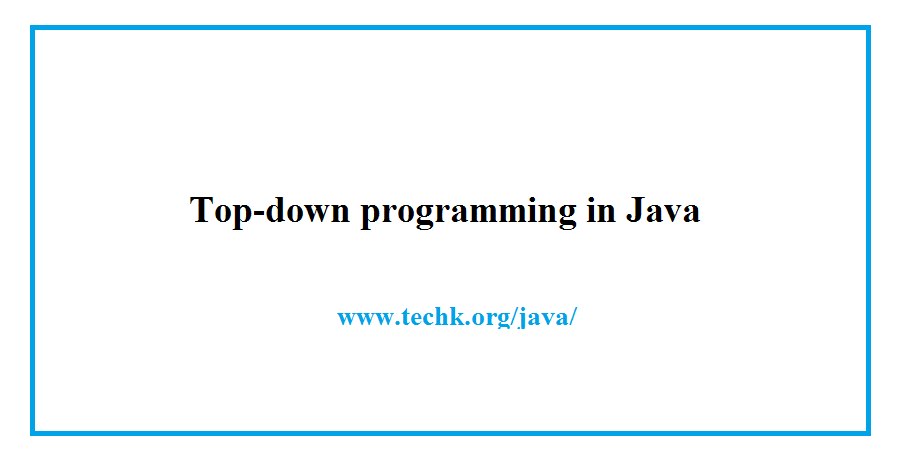What Is Top-Down Programming In Java?
Category: JAVA | 14th October 2024, Monday

Top-down Programming, Also Known As Stepwise Refinement, Is A Programming Methodology Where The Development Process Begins With Outlining The Highest-level Components And Then Progressively Refining These Into More Detailed And Specific Components. This Approach Emphasizes Breaking Down A System Into Smaller, Manageable Parts Or Modules, Starting From The Top-most Level Of The System Hierarchy And Working Downward.
Key Principles Of Top-Down Programming
- Hierarchical Decomposition: The System Is Divided Into Sub-systems Or Modules. Each Module Is Further Broken Down Into Smaller Units Until The Most Basic Operations Are Defined.
- Abstraction: Focus Initially On The Broad Structure And High-level Functions, Deferring The Details Of Individual Components Until Later Stages.
- Stepwise Refinement: Continuously Refine Each Component In A Step-by-step Manner, Providing More Detail And Functionality At Each Stage.
Benefits Of Top-Down Programming
- Enhanced Clarity: Starting With A High-level Overview Helps In Understanding The System’s Overall Structure And Flow.
- Better Organization: The Approach Helps In Organizing Code And Ensuring A Logical Flow Of Control.
- Easier Maintenance: High-level Modules Are Easier To Understand And Maintain, And Changes Can Be Made At Higher Levels Without Affecting The Lower-level Modules.
- Facilitates Teamwork: Different Team Members Can Work On Different Modules Simultaneously, Improving Collaboration And Productivity.
Top-Down Programming In Java: An Example
To Illustrate Top-down Programming In Java, Let's Develop A Simple Banking Application. The High-level Components Include:
- Banking System: The Main Application.
- Account Management: Manages Bank Accounts.
- Transaction Processing: Handles Deposits And Withdrawals.
Step 1: High-Level Design
We Start By Defining The Main Structure And Interfaces.
public Class BankingSystem {
Public Static Void Main(String[] Args) {
// Initialize The Banking System
AccountManager AccountManager = New AccountManager();
TransactionProcessor TransactionProcessor = New TransactionProcessor(accountManager);
// Example Operations
AccountManager.createAccount("John Doe", 1000);
TransactionProcessor.deposit("John Doe", 500);
TransactionProcessor.withdraw("John Doe", 200);
}
}
Step 2: Define Account Management
Next, We Refine The AccountManager Class.
import Java.util.HashMap;
import Java.util.Map;
class AccountManager {
Private Map<String, Double> Accounts;
Public AccountManager() {
Accounts = New HashMap<>();
}
Public Void CreateAccount(String Name, Double InitialBalance) {
Accounts.put(name, InitialBalance);
}
Public Double GetBalance(String Name) {
Return Accounts.getOrDefault(name, 0.0);
}
Public Void UpdateBalance(String Name, Double NewBalance) {
Accounts.put(name, NewBalance);
}
}
Step 3: Define Transaction Processing
Finally, We Refine The TransactionProcessor Class.
class TransactionProcessor {
Private AccountManager AccountManager;
Public TransactionProcessor(AccountManager AccountManager) {
This.accountManager = AccountManager;
}
Public Void Deposit(String Name, Double Amount) {
Double CurrentBalance = AccountManager.getBalance(name);
AccountManager.updateBalance(name, CurrentBalance + Amount);
}
Public Void Withdraw(String Name, Double Amount) {
Double CurrentBalance = AccountManager.getBalance(name);
If (currentBalance >= Amount) {
AccountManager.updateBalance(name, CurrentBalance - Amount);
} Else {
System.out.println("Insufficient Funds For " + Name);
}
}
}
Summary
Top-down Programming In Java Involves Starting With A High-level Design And Gradually Refining It Into More Specific And Detailed Components. In The Example Above, We Started With The Main BankingSystem Class And Then Refined The AccountManager And TransactionProcessor Classes. This Method Helps In Maintaining A Clear Structure, Improving Code Readability, And Facilitating Easier Maintenance And Collaboration. By Focusing On High-level Functionalities First, Developers Can Ensure That The Overall System Architecture Is Sound Before Diving Into The Finer Details Of Implementation.
Tags:
Top-down Programming, Java Top-down Programming
